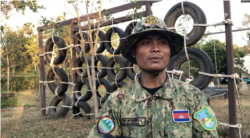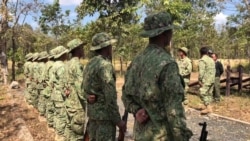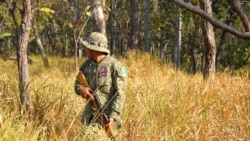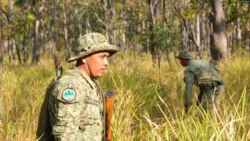The 20 or so very fit men gathered deep in the forests of northeast Cambodia at the Tropaing Tear Base in the Srepok Wildlife Sanctuary.
On their uniforms, a patch richly embroidered with the map of Cambodia and its protected landscapes, elephants, tigers, one of the national flowers and the Ministry of Environment logo did little to counter their overall don’t-mess-with-us attitude.
“I live in the forest more than my home,” said Reth Phearun, a 26-year-old ranger who commands the Chas Yang Base in the Srepok Wildlife Sanctuary. Half a century ago, the region rivaled the East African savannah for its diversity and abundance of wildlife -- banteng, Asian elephants, Eld’s deer, Indochinese tigers, leopards and more.
Today, those beasts exist in critically low numbers, but the recent and increased protection effort “leaves hope that, at some point in the future” wildlife populations in the region “can be restored to their former glory,” according to the World Wildlife Fund.
That’s where Reth Phearun comes in. One of six rangers who recently received awards for outstanding service, he was born in the province’s Koh Nhek district, graduated from high school in 2013 and began his ranger career three years ago.
Nationwide, Cambodia employs some 1,200 rangers to guard endangered species on more than 7.3 million hectares of protected forests, according to the Ministry of Environment. In the critical 6,000-square-kilometer bioregion of the Srepok and Phnom Prich Wildlife Sanctuary, there are just 51 rangers, 46 wildlife guards and 588 community patrol teams.
These vast areas swallow this protection. In Mondulkiri province, there is less than one ranger per 100 square kilometers, far below the international standard of eight rangers for that amount of territory.
Although few Cambodians want to become rangers, those who do see the job as a calling, putting themselves in danger and sacrificing home life.
The rangers patrol Srepok Wildlife Sanctuary four times a month on trips over four days and three nights, according to Reth Phearun.
“It is very challenging at night in some areas. We get no sleep at night, and must help each other patrol until morning,” he said.
Reth Phearun worries about encounters with poachers and loggers, saying, “If they see us, they will definitely shoot us. They are not afraid of us at all.”
One of his colleagues, Cheng Chanty, was sleeping near a creek in the Srepok Wildlife Sanctuary when poachers arrived around 3 a.m. Jan. 29, 2019.
“They were on motorbikes,” said Cheng Chanty, 42. “We told them to stop, but they didn't. We followed them and they shot at us. I was shot in my front abdomen and the bullet went through to my buttock.” The wound took four months to heal.
All of the alleged poachers remain at large. Cheng Chanty remains on the job.
The attack on Cheng Chanty was not unusual.
An Environment Ministry ranger, a Wildlife Conservation Society staffer and a military police officer were killed by Cambodian armed forces aligned with illegal loggers in the province’s Keo Seima District on Jan. 30, 2018.
Six law enforcement officers, three of them police who usually worked on the Cambodia-Vietnam border, were arrested and detained. In October 2019, the shooter, Phal Penh, a border post chief, was sentenced to life in prison and two accomplices were sentenced to 30 years and two years in prison.
Two months later, the U.S. Treasury sanctioned the Cambodian tycoon Try Pheap, saying he “has used his vast network inside Cambodia to build a large-scale illegal logging consortium that relies on the collusion of Cambodian officials, to include purchasing protection from the government, including military protection, for the movement of his illegal products.”
A 2015 report by Global Witness called Try Pheap, the “King of Rosewood,” and stated that more than $5.6 million in timber by Try Pheap Group was exported to the Hong Kong-based Kin Chung Transportation Company.
The rangers have only five days off a month, which upends any hope of work-family balance. “I have brothers to talk and joke with here,” said Reth Phearun. “I am closer with them than I am with my wife and children,” he joked.
The son of farmers and wine makers, Reth Phearun is the fifth of six children. Recently married, he now has a 6-month-old son.
“When my wife was giving birth, I got only five days off,” he said.
His family pitched in when Reth Phaerun returned to the forest. “I cannot leave my work for too long, because the more time I take day off, the more the forest crime there is.”
His solution is to take one day off “when I miss my son,” he said.
Kroeurng Tola, a representative of the Bunong indigenous community, acknowledged the rangers’ efforts but said they are limited.
An activist who exposes misuse of natural reserves, Kroeurng Tola said, “Our rangers have strong will in protecting the forest and wildlife, but their job is still being limited when there are orders from the higher level not to arrest any culprit.”
Reth Phearun remains passionate about protecting the forests and its endangered wildlife.
"I want to improve my (ranger) base" with a bigger building fully supplied with electricity and linked into the mobile network, he said, adding a better road to improve accessibility and more rangers would be good, too.
“I want to see wildlife and forest increase" he said. "And I want to see tourists coming in and out in the future. If there are tourists, we will benefit from them.”














